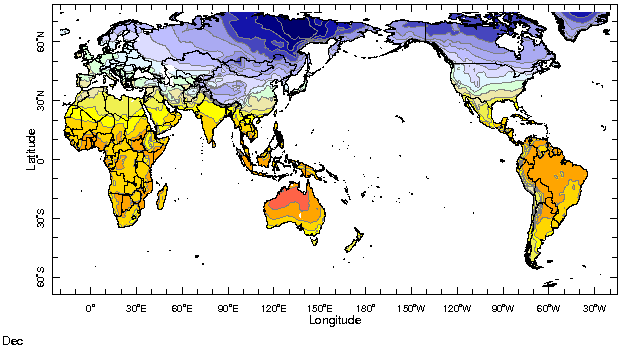|
IRI Climate Digest
January 2005
December Global Climate Summary
Climatological Background
In December, the Northern Hemisphere enters the heart of winter, with strong north-south temperature differences driving the mid-latitude jet stream and storm systems. In the Southern Hemisphere summer is under way, with monsoon systems gaining strength in South America, southern Africa, and Australia.
Monthly Mean Temperature (1961-1990), data from the Climate Research
Unit, University of East Anglia


Monthly Mean Precipitation (1961-1990), data from the Climate Research
Unit, University of East Anglia


Temperatures
Highlights
Following an unusually warm November temperatures plummeted across much of north-central Asia in December, with colder-than-average conditions extending from the Ural mountains eastward to Siberia. Below-average temperatures also emerged across most of eastern Canada during the month. Above-average temperatures persisted from southern Alaska southeastward across western Canada into the northern Plains of the US. Generally above-average temperatures were the rule across much of eastern and northern Europe, Brazil, and much of the African continent. The global average temperature for 2004 (Jan-Dec) ranked as the fourth highest for the period covering 1880-present (NCDC).
Temperature Difference from the 1961-1990 mean, with data
from NCEP Climate Prediction Center, CAMS.


Precipitation
Highlights
Above-average rainfall brought some relief to persistent dry conditions across western Indonesia and southern peninsular Malaysia, and flooding to parts of Sri Lanka. Precipitation was generally above average across southern Africa, although pockets of unusually dry conditions persisted across southern Mozambique, South Africa, and westward into Namibia and Angola. Generally below-average precipitation was observed over much of Brazil and northern South America, with some locally very heavy rainfall across portions of Colombia. Very heavy rain fell in the lower elevations of the southwestern US, with heavy snowfall occurring in mountainous regions during the month.
Precipitation Difference from 1979-1995 mean, with data
from NCEP Climate Prediction Center, CAMS-OPI.


Oceanic Conditions
Tropics Ocean temperatures have not changed significantly over the past month in the equatorial Pacific, with slightly warmer-than-average conditions persisting from near the dateline eastward across the east-central portions of the basin. These higher-than-average temperatures are typical of a weak El Niņo, and are expected to persist for at least the next few months. See the ENSO Quick Look and the IRI ENSO Update for more information. Sea surface temperatures remained above average across the equatorial Indian Ocean and in the tropical North Atlantic.
Extratropics Above-average sea surface temperatures were observed across the central and northern North Atlantic and in the east-central North Pacific. Warmer-than-average surface waters were also observed across the central and southern South Pacific, with colder-than-average conditions in midlatitudes in the eastern and western portions of the South Pacific basin. Below-average temperatures were also observed across the southern South Atlantic and southern Indian oceans during the month.
Monthly Sea Surface Temperature Difference from the 1971-2000 mean,
with data from the Environmental Modeling Center, NCEP/NOAA.


Contents |
Special |
Impacts |
Climate |
Forecast
|

